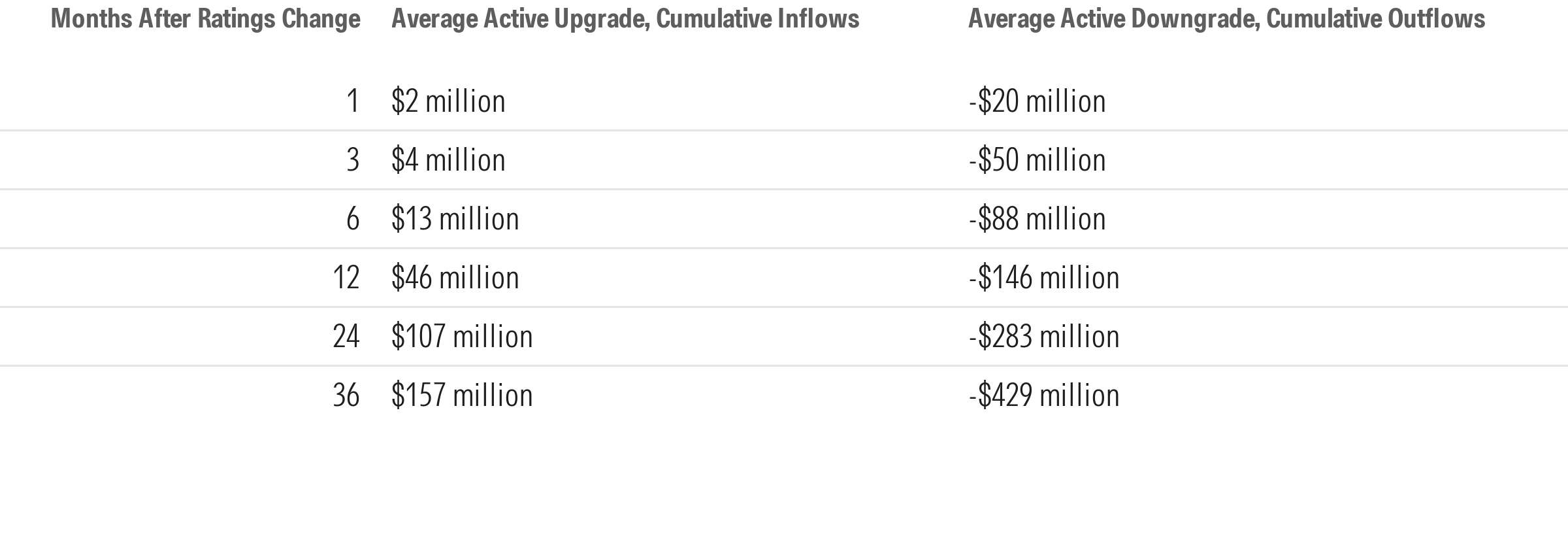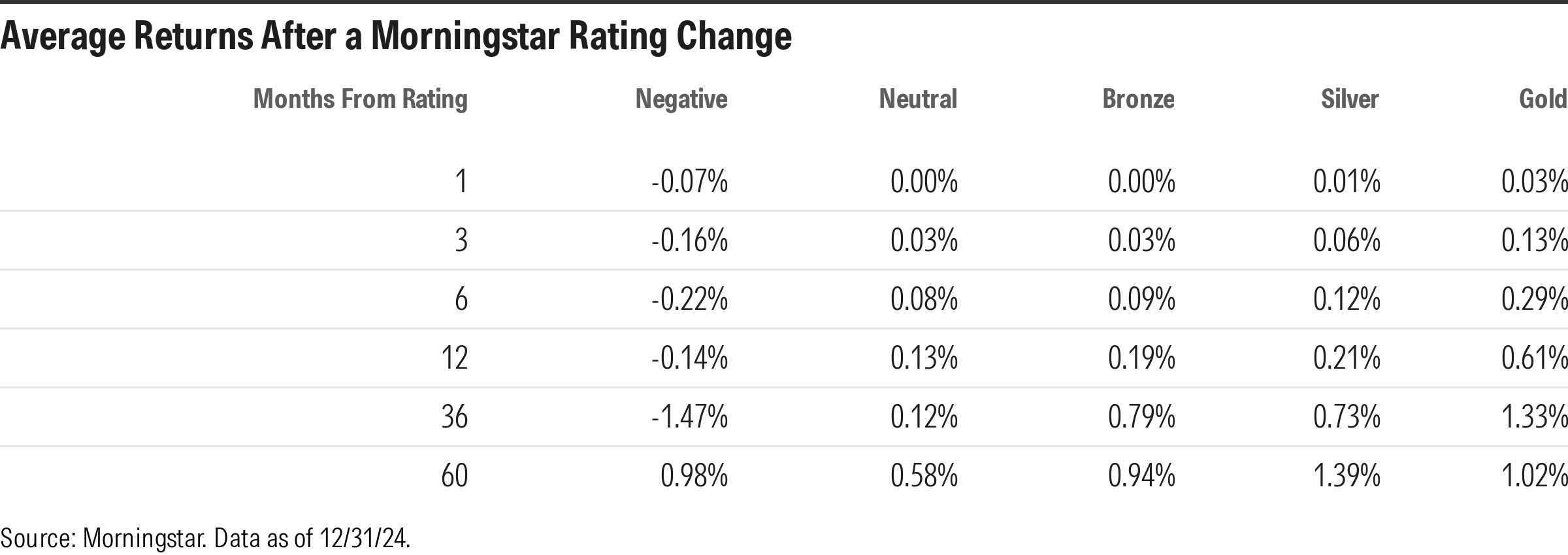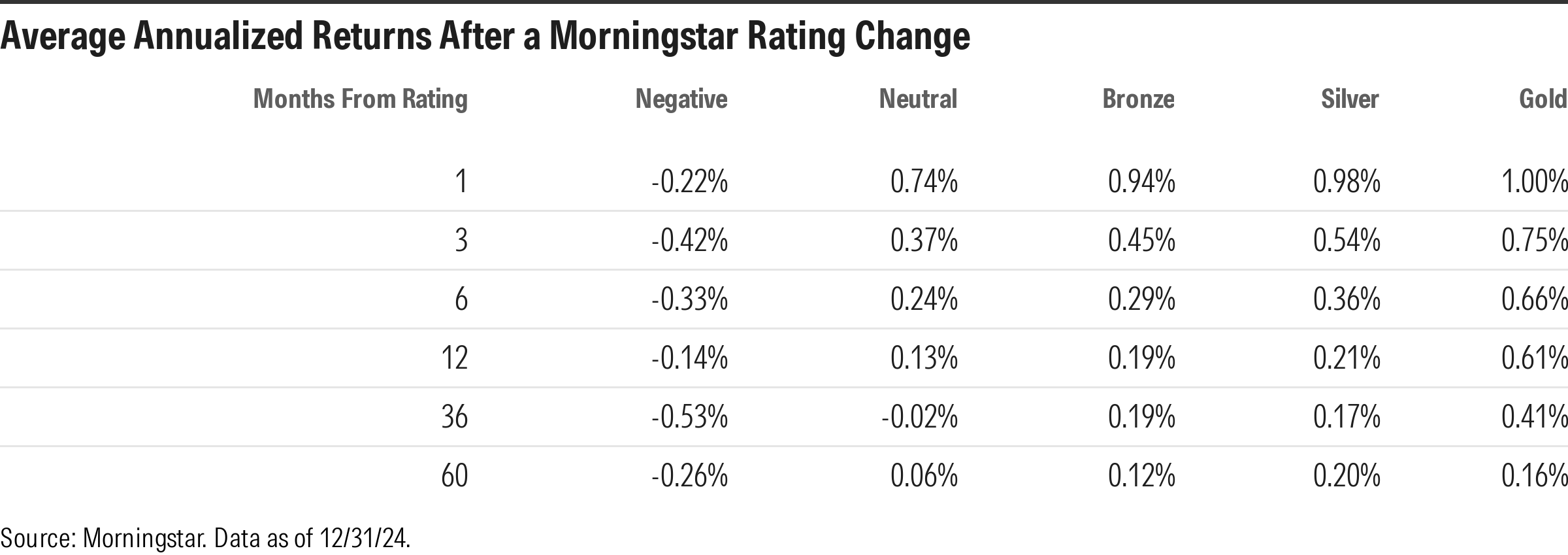4 min read
The Link Between Morningstar Ratings, Flows, and Performance
The data behind rating changes and their relationship to investor sentiment.

Millions of investors use Morningstar ratings as a starting point for finding, comparing, and tracking potential investments. To understand the reliability of our ratings, we turned our rigorous independent research frameworks on ourselves.
In our most recent study, we found that ratings have reliably sorted funds based on future performance. We also found a positive correlation between analyst ratings and fund flows.
Here’s what the data reveals.
Morningstar Medalist Rating vs. Star Rating: What’s the Difference?
The Medalist Rating is an analyst’s assessment of a fund’s potential to outperform its relevant benchmarks and peers over the long term. It’s a forward-looking tool based on investment fundamentals: people, process, and parent.
The Medalist Rating doesn’t try to guess the most successful mutual funds and ETFs of the next six months. Instead, it prioritizes long-term competitive advantages.
In contrast, the Morningstar Rating—often simply called the “star rating”—looks backward at historical performance. It’s a risk-adjusted return measure reflecting a fund’s performance relative to peers over the trailing three-, five-, and 10-year periods. While past performance can’t guarantee future returns, the star rating system helps investors compare funds’ track records against similar investments.
Both ratings are only the first stop in a thorough research process, offering an initial screen to simplify the early stages of exploration.
How Do Morningstar Ratings Affect Fund Flows?
A 2023 Morningstar study tracked the correlation of fund flows to rating changes, covering the 12-year period that ended in 2022.
The study showed a link between analyst ratings for actively managed funds and flows. Data indicated that active funds with improved Medalist Ratings tend to steadily attract investor money for up to 36 months compared to peer groups. On average, active funds netted $157 million in inflows over the three years after a Medalist Rating upgrade.
For context, active funds have witnessed steady outflows overall over the past decade as investors flock to low-cost passive vehicles.
On the other hand, funds with lower Medalist Ratings tended to experience outflows over the same time periods. The average active fund lost $429 million to outflows over the three years post-Medalist Rating downgrade.
Those outflows are often heavier from the start.
Downgrades of active funds showed a stronger link to outflows. One reason might be that we often downgrade funds based on point-in-time events, like a fund manager’s departure or a brush with capacity constraints.
Upgrades are based on a more gradual process of proof over time as funds weather market headwinds, gradually improve performance, or add to their support staff. The investing community also rarely agrees on exactly when to upgrade a fund.
For passive funds, where fundamentals change less often, we observed no link between the analyst rating and flows.

Limitations of Morningstar Ratings
Nothing, including Morningstar ratings, is a guarantee of future performance.
This study focuses on correlation and doesn’t definitively indicate that the ratings change was the cause of shifting flows. Of course, many factors can influence fund flows, including market conditions and recent performance.
That might be why the link between the start rating and flows is relatively stronger. The rating is updated monthly and responds more to performance changes.
How Well Do Morningstar Ratings Predict Performance?
The Morningstar research team regularly evaluates how well our ratings work to understand where we can improve and answer the question: “Are Morningstar ratings reliable?” Since its launch in 2011, the Morningstar Medalist Rating has successfully sorted funds based on future performance. Higher-rated funds fared better, on average, than lower-rated ones.
However, highly rated funds didn’t generate higher average excess returns than their assigned indexes, on average.


While the goal of the star rating isn’t to predict returns, it also effectively sorted funds based on their future performance, with higher-rated funds far likelier to survive and outperform average peers than lower-rated funds.
While it has struggled in the short term, the rating did a good job of sorting funds over the trailing three-, five-, and 10-year periods.
The Bottom Line: What Does This Mean for Fund Managers?
While a Medalist Rating upgrade doesn’t guarantee a flood of new investors, the data shows a correlation between active fund flows and ratings changes. Morningstar ratings are also an accurate sorter of high-performing funds from low-performing ones, making them a useful initial screen for investment opportunities.
By showing independent ratings next to sell-side research, fund managers can build investor confidencethrough transparency. Third-party analyses give investors another trusted perspective to consider when making investment decisions. At a glance, they tell a story about a fund’s investment merit and place within a diversified portfolio.